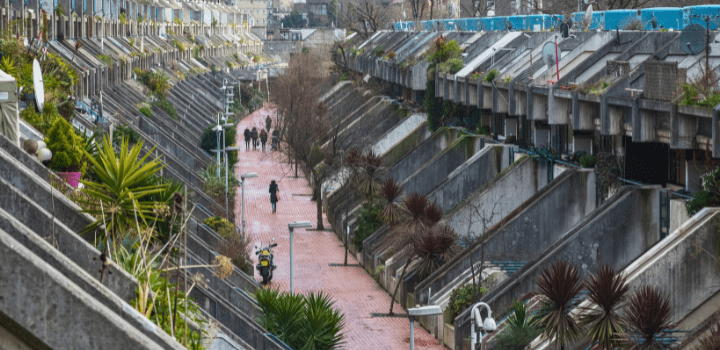The planning shake up must give us greener transport and other good things, not just housing – Inside track
4 min read
This post is by Lisa Hopkinson, director of Transport for Quality of Life.
The planning system is once again in the crosshairs as the new government proposes reform to “meets the needs of a modern economy” and deliver 1.5 million homes over five years. The new Planning and Infrastructure Bill shows it is front and centre of plans to revive the economy. Good planning is part of the solution and we need to ensure we don’t throw this proverbial baby out with the bathwater in the race to reform the system.
Transport planning is inextricably linked to meeting housing targets and land use planning, so any changes to the system or housing targets has implications for transport.
Deregulation and constant undermining of the planning system over the last few years has failed to build the houses needed and has had many unintended negative consequences for transport, the environment and our town centres.
It’s possible to build more houses and meet other aimsThe UK has some of the worst urban sprawl in Europe, with ugly monofunctional development on the edge of settlements or out of town, tarmacking over green fields, wildlife habitats and recreational spaces. This sprawl has, in turn, created a high degree of car dependency and degraded our town centres.
Planning reform (both land use and transport) is important but focusing on the single goal of housebuilding should not then undermine other important policy goals, such as health, quality of life, carbon reduction and nature recovery.
So how can we accommodate a growing population, promote sustainable travel and protect land for other vital needs, such as food production and wildlife habitat without sprawling into the countryside?
Transport for Quality of Life’s report Planning for less car use suggests that, with some key changes to the National Planning Policy Framework, it should be possible to build more homes (especially social housing), while at the same time improving quality of life, reducing car dependency, mitigating climate change and creating more green jobs.
High density doesn’t have to mean high riseTo avoid urban sprawl, we need to build up rather than out, and concentrate development as much as possible on brownfield sites in existing urban areas. While this may conjure up visions of 1960s tower blocks, higher building density does not necessarily mean high rise. The much admired Royal Crescent in Bath or the award winning Goldsmith Street social housing development in Norwich achieve high building densities with three to four storey dwellings that add character as well as providing green space for children to play. More town centre living will also enable more car-free housing developments to be built, while increasing footfall to rejuvenate high streets and town centres.
CPRE’s latest State of brownfield report shows that, in 2022, there were over 27,000 hectares of brownfield land in England. That’s enough to accommodate over 2.2 million homes at the density of Goldsmith Street.
We need to ensure that new developments are planned around public transport, walking and cycling to give residents good alternatives and ease the pressure on existing roads. Better bus services and walking and cycling infrastructure benefits everyone, by reducing traffic and providing alternatives. There is also plenty of evidence which shows a greener transport system can also boost prosperity for the country.
Better design can avoid the need for new roadsWe don’t need expensive new large roads to provide more housing. Work by Create Streets and Sustrans showed that a plan for a new housing extension to the market town of Chippenham, based on a £75 million large road scheme, could be redesigned for people instead of cars. Their revised scheme delivers the same number of homes with a much smaller loss of greenfield land. It would also reduce the spending on roads to £10 million whilst upgrading rail and bus services, cycle routes, town centre facilities and supporting local businesses.
One of the big problems with transport planning is that England (unlike Scotland and Wales) does not have an integrated transport strategy, but rather a set of strategies for individual modes (road, rail, bus, active travel and nothing for light rail and trams) that, in many cases, have competing aims and budgets.
As with housing, transport should not be focused on economic growth alone, at the expense of other policy aims. Better health and wellbeing, fairness, reducing carbon dioxide and polluting emissions, as well as greater prosperity, would be a good list of starting aims for an integrated transport strategy.
Any appraisal process of options should also include so-called ‘triple access planning’, ie reducing the need to travel (digital connectivity), switching to shorter trips through better planning (spatial proximity) and switching some car journeys to other modes (physical mobility).
The new government has inherited planned road schemes based on outdated assumptions, which merit an urgent and fundamental review. Many of them, some planned twenty or more years ago, are no longer fit for purpose and are not good value for money. The government’s announcement to scrap the A303 Stonehenge and A27 schemes is to be welcomed. But there are other ‘dinosaur road’ schemes (eg the Lower Thames Crossing) where the billions of pounds allocated could be better used to invest in public transport and active travel infrastructure and services, which provide multiple other social, economic and environmental benefits.
Finally, the government needs to address a long term anomaly in the National Networks National Policy Statement (for strategic roads and rail) and remove the presumption for roads. We need a fair and transparent appraisal process to determine how we best meet our travel needs for every community in every part of Britain.
Discover more from Inside track
Subscribe to get the latest posts sent to your email.





